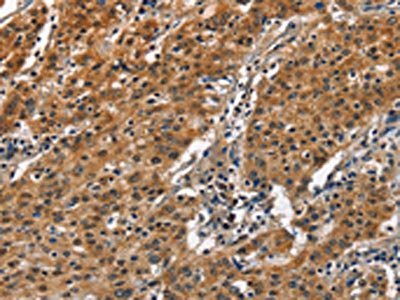SLAMF8 Antibody
-
货号:CSB-PA921557
-
规格:¥1100
-
图片:
-
The image on the left is immunohistochemistry of paraffin-embedded Human thyroid cancer tissue using CSB-PA921557(SLAMF8 Antibody) at dilution 1/50, on the right is treated with fusion protein. (Original magnification: ×200)
-
The image on the left is immunohistochemistry of paraffin-embedded Human gastric cancer tissue using CSB-PA921557(SLAMF8 Antibody) at dilution 1/50, on the right is treated with fusion protein. (Original magnification: ×200)
-
-
其他:
产品详情
-
Uniprot No.:Q9P0V8
-
基因名:SLAMF8
-
别名:B-lymphocyte activator macrophage expressed antibody; BCM-like membrane protein antibody; BLAME antibody; CD353 antibody; SBBI42 antibody; SLAF8_HUMAN antibody; SLAM family member 8 antibody; Slamf8 antibody
-
宿主:Rabbit
-
反应种属:Human
-
免疫原:Fusion protein of Human SLAMF8
-
免疫原种属:Homo sapiens (Human)
-
标记方式:Non-conjugated
-
抗体亚型:IgG
-
纯化方式:Antigen affinity purification
-
浓度:It differs from different batches. Please contact us to confirm it.
-
保存缓冲液:-20°C, pH7.4 PBS, 0.05% NaN3, 40% Glycerol
-
产品提供形式:Liquid
-
应用范围:ELISA,IHC
-
推荐稀释比:
Application Recommended Dilution ELISA 1:1000-1:5000 IHC 1:50-1:200 -
Protocols:
-
储存条件:Upon receipt, store at -20°C or -80°C. Avoid repeated freeze.
-
货期:Basically, we can dispatch the products out in 1-3 working days after receiving your orders. Delivery time maybe differs from different purchasing way or location, please kindly consult your local distributors for specific delivery time.
相关产品
靶点详情
-
功能:May play a role in B-lineage commitment and/or modulation of signaling through the B-cell receptor.
-
亚细胞定位:Membrane; Single-pass type I membrane protein.
-
组织特异性:Expressed in lymph node, spleen, thymus and bone marrow.
-
数据库链接:
HGNC: 21391
OMIM: 606620
KEGG: hsa:56833
STRING: 9606.ENSP00000289707
UniGene: Hs.438683
Most popular with customers
-
-
YWHAB Recombinant Monoclonal Antibody
Applications: ELISA, WB, IF, FC
Species Reactivity: Human, Mouse, Rat
-
Phospho-YAP1 (S127) Recombinant Monoclonal Antibody
Applications: ELISA, WB, IHC
Species Reactivity: Human
-
-
-
-
-






















